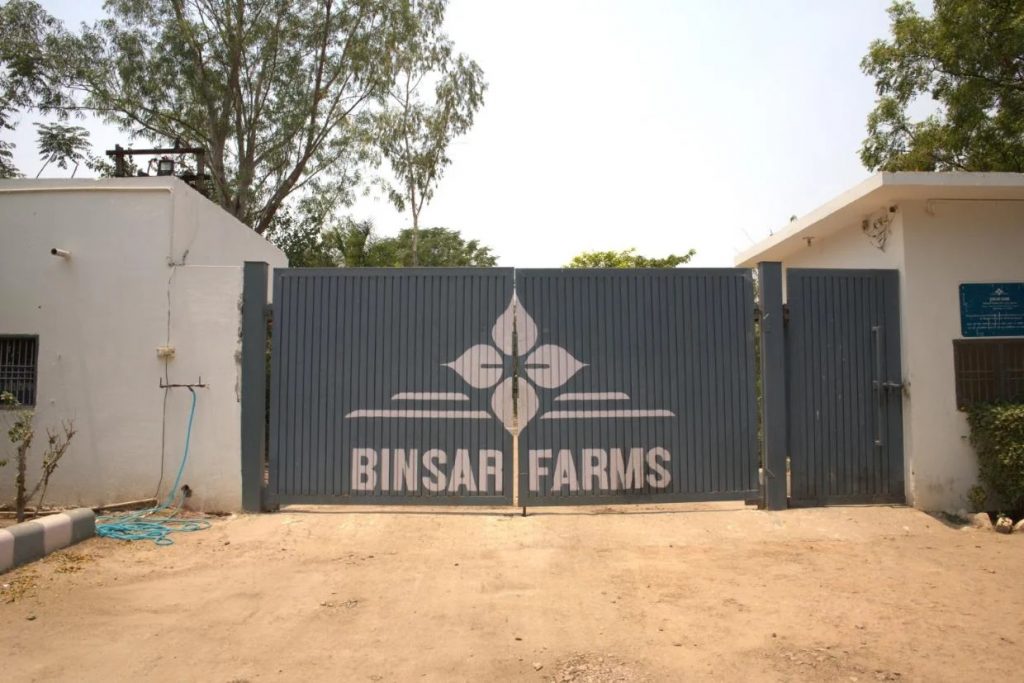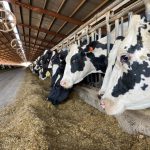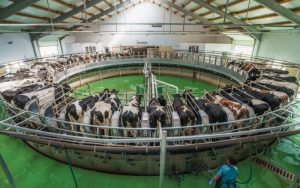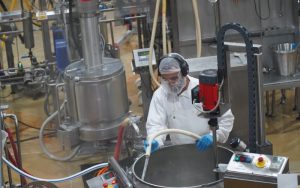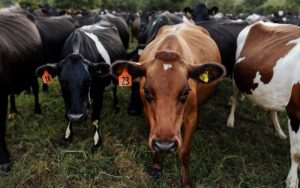
On the border of Delhi and Haryana in northern India, in the village of Janti Khurd, bluntly translated as ‘small community’, you are more likely to encounter a traffic jam of ox than the vehicle pileups you see on the way there from nearby New Delhi.
It’s here that in 2010 IT expert Deepak Raj and two colleagues Pankaj Navani and Sukhvinder Saraf had an idea to turn Raj’s ancestral land into a productive, profitable farm that could benefit the wider community.
 A traffic jam near the small village.
A traffic jam near the small village.KELLY DENNETT / SUNDAY STAR-TIMES
But for this trio of tech experts, despite their dream, dairy farming was novel. Humble enough to know they needed help, they sought expertise – contacting dairy professionals all over the world to find a mentor.
Many offered to help, Raj explains from the Binsar Farms office in Janti Khurd on a typically hot Indian (40C) summer’s day. Nearly 15 years after the idea was conceived, in the corner of the office now proudly sits a carving of Ranginui, and a cricket bat.
But those who expressed interest wanted to charge an hourly consultant’s rate and the fees seemed too transactional for the trio, who were seeking to launch an operation with heart.
Then they heard from dairy industry veteran Earl Rattray. The chair of Dairy Farms NZ, Rattray was one of the founding members of Fonterra, and Raj knew Rattray’s experience in New Zealand, a place where dairy operations were far more advanced, would be a boon.
 Deepak Raj waited a year before deciding to quit his tech job – there was a lot of trial and error to begin with.
Deepak Raj waited a year before deciding to quit his tech job – there was a lot of trial and error to begin with.KELLY DENNETT / SUNDAY STAR-TIMES
“He was kind enough to visit India and see that there is a lot of opportunity here,” says Raj. By then, they’d already made a soft launch of what would become Binsar Farms, with a small herd occupying a bamboo shed, “just to see if we can do this or not”.
The men were reluctant to quit their tech jobs until they knew a farm was viable.
“It was a courageous step for [Earl] to visit. It was a lucky thing for us.”
As Rattray says now, “we connected, I liked their story and strategy. And it went from there.”
 The village of Janti Khurd, about an hour’s drive from Delhi.
The village of Janti Khurd, about an hour’s drive from Delhi.KELLY DENNETT / SUNDAY STAR-TIMES
“It’s actually played out almost exactly as I expected it would,” says Rattray over the phone, who says strategic partnerships like these are just as much about the people you are working with, as they are about the outcome.
He’s just returned to New Zealand after a particularly hot quarterly trip to the farm. “I recall having some conversations with [Deepak, saying], ‘You guys gotta understand, this is going to take 10 years before becoming anything like an overnight success.’
“When you’re starting from nothing but an idea, and starting from scratch, and you’re taking an unconventional approach, there are going to be some lessons learned along the way.”
After starting out with 50 heifers and 10 acres, Binsar Farms is now operating across the Janti Khurd site as well as several satellite plots spanning 150 acres. It’s one of the biggest farms near Delhi, producing 1m litres of high quality, highly tested milk annually, delivered daily to 6000 homes in recyclable glass bottles.
So far Binsar has made 15 million deliveries through its website and app, its success largely owing to lessons from New Zealand, and Rattray, as well as perseverance, and sheer grit.
The farm also produces and sells paneer, yoghurt, ghee, flavoured (chilli) butter, and buttermilk. Visitors to Binsar can watch a dedicated paneer maker vacuum pack the creamy cheese that makes Indian curry so famous.
The organisation has engaged 250 people in the venture, including a lot of locals and, notably for a rural area, women. As well as its dairy herd, the farm hosts paddy crops and maize. New Zealand dairy farmers might notice the herringbone milking shed, pulsation systems brought in from Rangiora, and New Zealand-esque barns, although with more airflow.
 The open air barns allow for better circulation in a hot, Indian summer.
The open air barns allow for better circulation in a hot, Indian summer.KELLY DENNETT / SUNDAY STAR-TIMES
“We didn’t know earlier how far we can go,” says Raj. “Every year we’re thinking that like, it’s a last year for us, because we were not producing enough or we were not selling enough.”
For example, to begin with, when they initially bought 50 heifers, three immediately died. Two had disease and three had reproductive issues. In fact, they realised, they’d been cheated out of tens thousands of rupees as the seller surely knew the heifers had no reproductive organs. They were left with 40 cows.
“We thought, it’s not going to sustain a year, [but then] we realised what we could do differently. As IT and computer engineers, we could utilise our data.”
By 2017 they had collated 2 million data points which had taught them where they were going wrong. They quickly realised that cows gaining weight were in good health, and those that weren’t had an issue. They compiled graphs showing the weight disparities, some as much as 100kg, and realised a cow that wasn’t growing wasn’t producing as much milk and could be hard to impregnate.
 Many locals are involved in the venture, including women.
Many locals are involved in the venture, including women.KELLY DENNETT / SUNDAY STAR-TIMES
In 2015 they had a big dip in production when, during monsoon season, mastitis swept through a herd – an important lesson for the following year. A small spend on prevention could result in a lot of milk gain.
They began routine milk testing, tracking the ever dropping bacteria count and comparing it to other local suppliers.
Says Raj, “Nobody’s looking at these standards in India; somatic cell count or antibodies in milk – it’s a knowledge gap.”
The quality of milk in India is not high despite households consuming it en masse – most residences who receive a direct delivery from a farm will boil it (“home pasteurisation”, Raj calls it) before consumption.
“It’s all knowledge that we got from New Zealand,” says Raj, “What should be the quality standard that we should maintain, what quality parameters in international milk should contain.”
 Recognise the label?
Recognise the label?KELLY DENNETT / SUNDAY STAR-TIMES
The keen farmers learned how to grow their own feed, highly digestible, high protein green fodder, in place of pasture, observed the impacts of different seasons, how nutrition impacts milk solids, how to avoid common issues like lameness and mastitis; as well as the basics of hormones, genetics, breeding livestock, and taking a longterm view on things.
“Your cows may not give as much milk as other farmers, but they will give long term,” Raj says, repeating advice he gleaned from Rattray: “We need those cows who can stay longer in the farm. That’s why we are breeding KiwiCross and jerseys.” Big friesians don’t cope well in hot climates, but jersey cows, smaller animals, are much more heat tolerant.
“One good thing Earl taught us: you should maintain a professional kind of behaviour. It’s a farming venture, but it’s not like you should behave like farmers, you should behave like professionals, like a businessman.”
Rattray, a Binsar Farms shareholder and chair of the governing board but who describes himself as “that grumpy old dog who barks from under the stairs” and “handholder”, says despite India’s huge dairy industry, it doesn’t have the developed infrastructure or standards that New Zealanders take for granted.
 Making silage, by hand.
Making silage, by hand.SUPPLIED / SUNDAY STAR-TIMES
“You’ve almost got to find your way and develop that up yourself,” he says. “Breeding livestock is a longterm process, it doesn’t happen overnight, and buying them off the market is risky. So…we’ve basically been following our own path in terms of breeding and developing our genetics. We had done a lot of things there that I would call hybrid blend between what we do in NZ and what’s practical in India.
“But at the end, the principals are exactly the same, it is about having efficient converting animals, feeding them well, making sure animal welfare is taken care of… it takes awhile, and you have many setbacks along the way [but] we’re still there. That in itself is an achievement. And we’re still enthusiastic.”
Over the years Rattray, like many others who’ve experienced India, have seen its growth and believes the billion-plus population is on track to change the world. But he also sees a pull from rural settings to urban areas, which could leave the country’s agriculture and horticulture sectors vulnerable.
“As that economy grows, at the pace that it is growing, it is just going to absolutely suck labour and people out of rural India, into urban, and that creates a vacuum, a gap to be filled -and it will be these sustainable farming operations that will fill that gap,” he says.
The Binsar farmers have become so knowledgeable, the farm so successful – its revenue grew 50% last year – as well as inviting schoolchildren to visit, or dropping milk to schools for hungry kids, in the last seven years they’ve hosted workshops with more than 3000 farmers from scores of farms to pass on their skills. They’re looking into how AI can help their growth.
 Earl Rattray on one of his quarterly visits.
Earl Rattray on one of his quarterly visits.SUPPLIED / SUNDAY STAR-TIMES
There are opportunities for New Zealanders willing to give it a go in India, a place with a supercharged economy which the National-led Government is eyeing up for strategic trade partnerships. While the Government is eyeing up a Free Trade Agreement, the dairy discussions between the two countries are likely to be fraught, but as Trade Minister Todd McClay has said, and other experts have echoed, there are opportunities to make partnerships that are beneficial to businesses in both countries – like Binsar Farms.
Says Rattray: “It’s worked in our case. The private sector needs to find its own way with opportunities over there [but] they shouldn’t be scared. I’m very happy with it. It’s worked for us, and we’re very, very happy to share all the learnings from our mistakes with anyone else who has got an opportunity to do anything similar.
“New Zealanders, with the right part in India, can make a very, very big difference. The principals are the same, you just have to be very, very patient and play the long game.
“I would say that if we were doing it all again, we could find 100 things we could have done slightly different but the strategy would be the same, that’s for sure.”
As for Deepak Raj, he’s proud he was able to return to his village, and do something for his community.
“You don’t know what is coming in the future,” he says. “A lot of practical experience you gain and when you do practical experience, from theory to practical, you get a lot of knowledge and you get a lot of failures. But you get successes too.”
Kelly Dennett travelled to India with assistance from the Asia New Zealand Foundation.
You can now read the most important #news on #eDairyNews #Whatsapp channels!!!
🇺🇸 eDairy News INGLÊS: https://whatsapp.com/channel/0029VaKsjzGDTkJyIN6hcP1K
